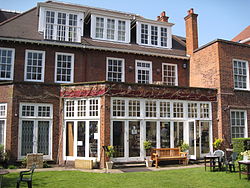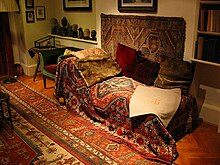Freud Museum
51°32′54″N0°10′40″W/ 51.54833°N 0.17778°W
 The Freud Museum, as seen from the garden | |
| Established | 28 July 1986 |
|---|---|
| Location | Maresfield Gardens London,NW3 United Kingdom |
| Public transit access | |
| Website | freud.org.uk |
TheFreud MuseuminLondonis a museum dedicated toSigmund Freud,located in the house where Freud lived withhis familyduring the last year of his life. In 1938, after escapingNazi annexation of Austriahe came to London via Paris and stayed for a short while at 39 Elsworthy Road before moving to 20Maresfield Gardens,where the museum is situated. Although he died a year later in the same house, his daughterAnna Freudcontinued to stay there until her death in 1982. It was her wish that after her death it be converted into a museum. It was opened to the public in July 1986.
Freud continued to work in London and it was here that he completed his 1939 bookMoses and Monotheism.He also maintained his practice in this home and saw a number of his patients for analysis. The centrepiece of the museum is the couch brought fromBerggasse 19, Viennaon which his patients were asked to say whatever came to their mind without consciously selecting information, named thefree association techniqueby him.
The museum was the subject of Part 2 ofRichard Macer's 3 part BBC documentary series 'Behind the Scenes at the Museum' in 2010.[1]
The museum's president isDavid Freud,the great-grandson of Sigmund Freud and architect ofUniversal Credit.[2]
There are two other Freud Museums, one inVienna,and another inPříbor,theCzech Republic,in the house where Sigmund Freud was born.
Location and description[edit]

The museum is located at 20 Maresfield Gardens in Hampstead, one of London's suburbs.
The ground floor of the museum houses Freud's study, library, hall and the dining room. The museum shop is on ground floor as well. The first floor has a video room, Anna Freud's room and there is a temporary exhibitions room which hosts alternatecontemporary artand Freud-themed exhibitions. Art installations often use several rooms within the museum, such as the 2001/02 exhibition"A Visit to Freud’s"by Austrian photographerUli Aigner.Many areas such as the kitchen and Anna Freud's consulting room are out of public view and have been converted into offices.
Building[edit]
The house had only finished being built in 1920 in theBritish Queen Anne Revivalstyle. A small sun room in a modern style was added at the rear byErnst Ludwig Freudthat same year. Freud was over eighty at this time, and he died the following year, but the house remained in his family until his youngest daughterAnna Freud,who was a pioneer of child therapy, died in 1982.
The house has a well maintained garden which is still much as Freud would have known it.[3]
Collection[edit]

The Freuds moved all their furniture and household effects to London. There areBiedermeierchests, tables and cupboards, and a collection of 18th century and 19th century Austrian painted country furniture. The museum owns Freud's collection ofEgyptian,Greek,Roman,andOrientalantiquities, and his personal library.
The star exhibit in the museum is Freud's psychoanalytic couch, which had been given to him by one of his patients, Madame Benvenisti, in 1890. This was restored at a cost of £5000 in 2013.[4]
The study and library were preserved byAnna Freudafter her father's death. The bookshelf behind Freud's desk contains some of his favourite authors: not onlyGoetheandShakespearebut alsoHeine,MultatuliandAnatole France.Freud acknowledged that poets and philosophers had gained insights into the unconscious which psychoanalysis sought to explain systematically. In addition to the books, the library contains various pictures hung as Freud arranged them; these include 'Oedipus and the Riddle of the Sphinx' and 'The Lesson of Dr Charcot' plus photographs ofMartha Freud,Lou Andreas-Salomé,Yvette Guilbert,Marie Bonaparte,andErnst von Fleischl.
The collection includes a portrait of Freud bySalvador Dalí.[5]
The museum organises research and publication programmes and it has an education service which organises seminars, conferences and educational visits to the museum. The museum is a member ofthe London Museums of Health & Medicine.[6]
See also[edit]
References[edit]
- ^"Behind the Scenes at the Museum".RadioTimes.Retrieved18 March2020.
- ^"A New President and New Trustees".Freud Museum London.27 May 2020.Retrieved18 September2021.
- ^"Garden".Freud Museum London. Archived fromthe originalon 20 March 2017.Retrieved3 April2016.
- ^"If you're sitting comfortably…a trip to the Sigmund Freud museum!".Jewish News Online.23 October 2015.Retrieved3 April2016.
- ^"About the Museum".Freud Museum London.Retrieved23 August2012.
- ^"Medical Museums".medicalmuseums.org.Retrieved26 August2016.
External links[edit]
- 1986 establishments in England
- Biographical museums in London
- History of mental health in the United Kingdom
- Egyptological collections in London
- Grade II listed buildings in the London Borough of Camden
- Grade II listed houses in London
- Houses in Hampstead
- Historic house museums in London
- Medical museums in London
- Museums established in 1986
- Queen Anne architecture in the United Kingdom
- Museums in the London Borough of Camden
- Houses completed in 1920
- Sigmund Freud

